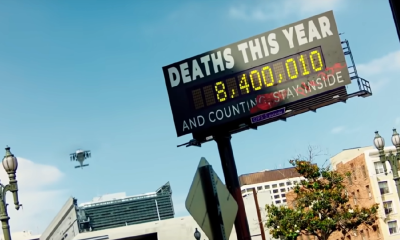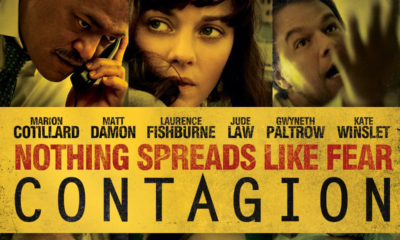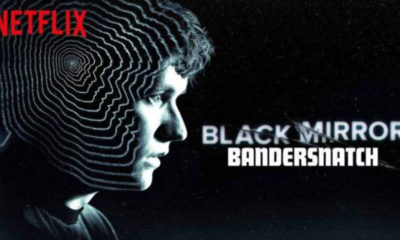Movies and TV
“Contagion”: How Disaster Movies “Educate” the Masses
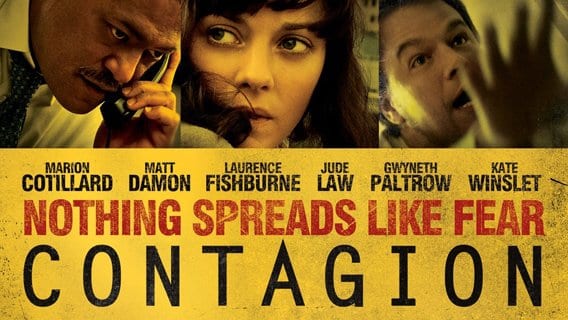
Most people watch movies to be entertained. Well, I for one can say that there was absolutely nothing entertaining about Contagion. In fact, the only difference between this movie and state-sponsored educational movies shown in schools is that with Contagion you actually have to pay to be indoctrinated … and to see Matt Damon. During the cold war, students were shown videos instructing them to “Duck and Cover” in case of a nuclear attack. Contagion conditions the masses to expect martial law and to throw themselves at the first available vaccine in case of a crisis.
Featuring Hollywood mega-stars like Matt Damon, Laurence Fishburne, Jude Law, and Gwyneth Paltrow, Contagion is a big-ticket Hollywood movie, but also an infomercial promoting specific national and international agencies while encouraging specific behaviors from the public. The plot of the movie appears to follow the big H1N1 scare of 2009 that left many citizens uncertain about the actual risk of the virus. Indeed, after months of terrifying news crowned by a massive vaccination campaign, an important portion of the population concluded that the H1N1 scare was grossly exaggerated and thought that a vaccine was unnecessary.
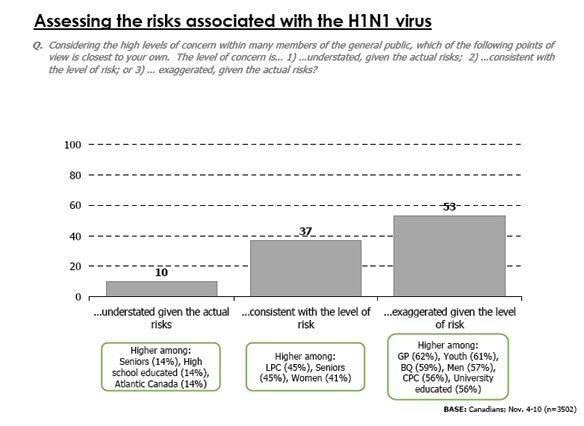
This poll taken in November 2009 shows that 53% Canadians believed that the risks associated with the H1N1 virus were exaggerated.
In the wake of this “crisis”, the UN’s World Health Organization (known as the WHO) was harshly criticized and even accused of colluding with Big Pharma to sell vaccines. The U.S. Centers for Disease Control and Prevention (the CDC) also had its credibility tarnished as investigations revealed that the agency misled the public regarding the number of actual cases of H1N1 (for example, see this report from CBS News). As a result, these two agencies needed a good PR stunt to restore their credibility and to scare the hell out of the public. This is where Contagion comes in.
Directed by Steven Soderbergh, Contagion was produced with the active cooperation of the CDC, the WHO, and other governmental organizations and its function are clear: To present a hyper-realistic disaster scenario to justify the vaccination campaigns promoted by these agencies while discrediting those who criticize them.
Nothing in the movie hints that it is a work of fiction. Quite to the contrary, everything in Contagion is made to be as realistic as possible, using actual locations and governmental agencies, to make the story as plausible – and as frightening to the masses – as possible. As the slogan of the movie says: “Nothing spreads like fear” and, boy, does it try to spread fear. This movie’s message is: “Nothing was exaggerated, and next time there’s a virus outbreak, listen to us … or you’ll die”.
The Function of Disaster Movies
Disaster movies are often action-packed thrill rides that venture into the sometimes fascinating “what if that happened” side of things. While some are over-the-top and border on fantasy, others, like Contagion, emphasize realism and actual events. These movies tend to “hit home” with the viewers because they lead them to think “this could happen to me”. Disaster movies exploit the latent fear that recent events caused on the psyche of the masses, tapping into the anxiety and trauma they cause in order to create tension and terror in the viewers. Then, the “agenda” aspect of these movies kick in as they propose to the viewers the best (and only) way these issues can be resolved. Specific groups and agencies are cast as honorable, helpful, and trustworthy during the time of crisis, while others are portrayed as hindrances and even traitors. The drama that follows becomes a case of predictive programming, as the steps taken in the movie to resolve the problem will thereafter appear normal to the masses if they ever occur in real life.
In his book Propagandes Silencieuses (Silent Propaganda), the journalist and writer Ignacio Ramonet describes the always present underlying message found in disaster movies:
“In all cases, the disaster causes a kind of ‘state of emergency’ that hands all powers and modes of transportation to state authorities: the police, the army or “the crew”. Portrayed as the ultimate recourse, these institutions are the only ones capable of facing the dangers, the disorder and the decay threatening society thanks to their structure and technical knowledge. (…) As if it was impossible to present to the general public a disaster that is not resolved by state authorities and governmental powers.”
– Ignacio Ramonet, “Propagandes Silencieuses” (free translation)
Along with the all-importance of authorities, the masses are inevitably presented as a herd of idiots prone to panic that must be kept in the dark.
“Another constant found in disaster movies is the infantilization of civilians. The full amplitude of the catastrophe and the danger the masses are facing is often hidden from them. They are kept out of any decision making process, with the exception of managers and technical specialists (engineers, architects, entrepreneurs) who are sometimes called to intervene in the crises, but always through state authorities.
The general public is often distracted with pointless entertainment and encouraged to obey without question to a ‘paternal and benevolent’ elite that is doing everything (to the point of self-sacrifice) to protect them.
These aspects, along with others, prove that disaster movies, beyond their entertaining value, also present a ‘political response’ to a crisis. Behind a naive mode of fantastic storytelling, a silent message is communicated to the public: the ruler’s profound desire to see entities such as the army, the police or ‘prominent men’ take charge of the restoration and the rebuilding of a society in crisis, even if this means partially sacrificing democracy”.
– Ibid.
Contagion follows Ramonet’s blueprint of disaster movies to a tee. Right from the start, specific organizations are identified as the go-to guys and are automatically given the power to act on a massive scale, namely FEMA, the WHO, the American Red Cross, and the CDC.
So what solution does Contagion propose in case of the outbreak of deadly disease? Martial law and mass vaccinations. What will happen if ever an actual disease would break out? Martial law and mass vaccinations. Would the masses question this type of drastic response to a crisis that might or might not be necessary? No, because hundreds of hours of media content have prepared the masses for this kind of situation. Let’s look at the main components and messages found in Contagion.
Fear Spreads Faster Than Germs
The movie starts by showing how a few sick people, who go about their daily routine, can easily contaminate thousands of people. The point of the introduction is simple: A deadly virus can spread around the world in a matter of days. This realistic yet terrifying scenario is an effective way to grip the audience and cause fear. During these scenes, the camera focuses for a few extra seconds on common objects that can transmit germs such as drinking glasses, just long enough for the viewer to realize: “Hey, I sometimes touch these things! That could be me! Aaaah!”

This sick guy could infect the entire bus.

Beware of glasses of water being handed to you…

Not even a mother’s hug is safe.
Most of those who are infected with the virus do not live long. In a series of heartbreaking scenes, one of the main characters, Mitch Emhoff (played by Matt Damon), sees his wife and his son lose their lives to the virus. Viewers watching this tragedy play out are led to think “Hey, that’s the most terrible thing that could happen to me! AAaaah!”

Watching Beth Emhoff (played by Gwyneth Paltrow) die from the virus is quite disturbing and certainly helps create a climate of fear.
After a few minutes of panic-inducing scenes, most viewers will say “Oh my God, someone needs to do something about this virus! This guy lost his wife and child! AAArgh!”. Heroes do step up to the plate and take charge of things … and it just so happens that they were involved in the making of the movie.
The Organizations That Take Charge
In Contagion, as soon as the virus becomes a threat, the entire American government escapes to an “undisclosed location” and “looks for a way of working online”. Meanwhile, specific real-life non-government organizations (NGOs) are identified by the movie as the “heroes” and the go-to people to handle the crisis. These organizations are given automatic legitimacy and trustworthiness. In short, the movie says: “If a crisis like this happens, the government will disappear, democracy will be suspended and NGOs will take over”.
The agencies identified by the movie are:
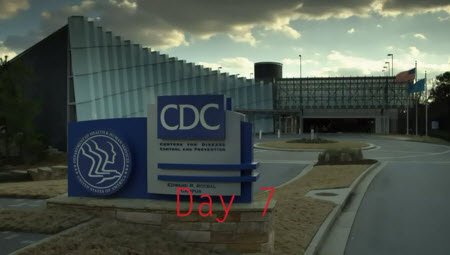
The CDC (Center for Disease Control), which has always heavily promoted vaccination campaigns.
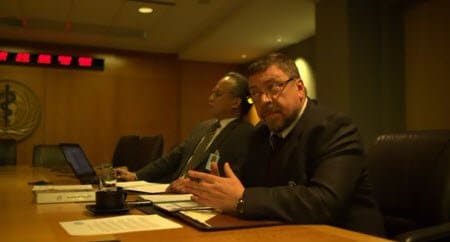
The World Health Organization (WHO) – which was accused, in the wake of the H1N1, of spreading “fear and confusion rather than immediate information”. In the movie, however, the WHO is an important factor in the resolution of the problem.
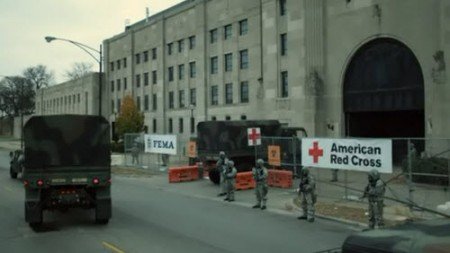
FEMA (Federal Emergency Management Agency) and the American Red Cross manage the civilians.

Of course, the U.S. Army is all over the place since martial law is defined as the “imposition of military rule by military authorities over designated regions on an emergency basis”.
So, in the wake of a “biological crisis”, the democratically elected American government basically dissolves and specific organizations (CDC, WHO, FEMA, the U.S. Army) take charge of all aspects of society. And this “taking charge” proceeds in a very specific way: Martial law and civilian camps.
Martial Law
In Contagion, the deadly virus is called MEV-1 and the social result of the outbreak is portrayed in a specific way. First, the general population, always depicted as idiotic, cattle-like, and prone to violence, spirals out of control. The masses are always shown panicking, yelling, stealing, fighting, and looting. This leads to a general breakdown of social order and a state of lawlessness.

A bunch of rude people looting a pharmacy to obtain medication.

The US Army imposes Martial Law and places the State of Minnesota in quarantine, blocking all traffic out of the state. Those who seek to leave the state are told to turn around and go back home.Citizens are then directed to FEMA camps.

This stadium has been turned into a FEMA camp.

Civilians (even healthy ones) have their rights revoked and are directed to FEMA camps where they are fed and lodged. In this scene, the lack of “individual meals” to feed all of the camp’s population causes a small riot.
The Conspiracy Theorist
If specific groups and organizations are identified by the movie as “competent” and “trustworthy”, other groups get a very different treatment, namely alternative media. Personified by a blogger named Alan Krumwiede (played by Jude Law), alternative media are presented as unreliable sources bent on sensationalism and profit. In other words, the movie implies that information that does not come from “official” sources is invalid and potentially dangerous. Not exactly a pro-free-speech message.
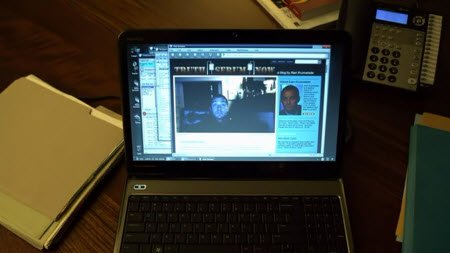
“Truth Serum”, a blog run by Alan Krumwiede, resembles the many “alternative news” website around the web. This type of information, which does not come from mass media or governmental sources, is definitely not portrayed in a positive light.
Right from the start, Alan Krumwiede is portrayed as a somewhat dodgy blogger with a questionable work ethic and who does not get much respect from the journalistic and the scientific community. When he tries to get one of his stories published in a newspaper, he gets rejected due to a lack of evidence behind his story. When he contacts a scientist regarding the virus, the scientist replies: “Blogging is not writing, it’s graffiti with punctuation”.
Despite this lack of respect from “competent” bodies, Alan Krumwiede has a wide audience and proudly boasts “millions of unique visitors per day” on his website. On it, he claims that a cure for the MEV-1 virus exists and is named Forsythia but it is repressed by the powers that be to sell vaccines. He also urges his readers not to take the vaccine that is given out by authorities.
The government apparently does not tolerate this kind of dissent. Krumwiede is ultimately arrested for “security fraud, conspiracy, and most likely manslaughter”.
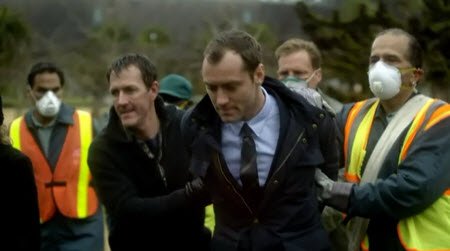
Krumwiede is arrested due to the contents of his blog. Contagion sends out a powerful message against “alternative” information sources: Diverging from “official sources” is dangerous and against the law.
Later, we discover that Forsythia was a lie and that Krumwiede made $4.5 million by promoting it to his readers. The chief of Homeland Security wants to put him in jail for a “long, long time”. However, due to his popularity, Krumwiede makes bail because, as the chief of Homeland Security states: “Evidently, there are 12 million people as crazy as you are”.
The character of Alan Krumwiede and the way he is portrayed is interesting for several reasons. First, he reflects the growing influence of blogs and alternative websites on public opinion – a recent phenomenon that does not sit well with the elite that seeks to have a monopoly of information. By depicting this character as dishonest, corrupt, and even dangerous to the public, the movie justifies the shunning of such writers and even their arrest. Nobody in the movie seems to mind that all of this is in direct violation of the First Amendment.
Second, when the H1N1 vaccine was released in 2009 and mass vaccination campaigns were organized, many citizens and authoritative figures including public health officials, doctors, and specialists spoke against it. They claimed that the vaccine was unnecessary, insufficiently tested and that it had negative side effects. By associating the corrupt figure of Alan Krumwiede with the “anti-vaccine movement”, the movie discredits all of those who question the necessity of mass vaccination campaigns. If another virus should strike, viewers of Contagion might be more prone to ignore these movements. In other words, the movie says: “Conspiracy theorists are corrupt liars that are dangerous to public safety and they should be arrested. Do not listen to them. They make money off phony cures. However, those who make even more money off phony vaccines are good. Listen to authorities and get the vaccine … or you’ll die.”
The Ultimate Solution
After months of horror and hundreds of millions of deaths, a final solution emerges to save humanity: Mass vaccination.
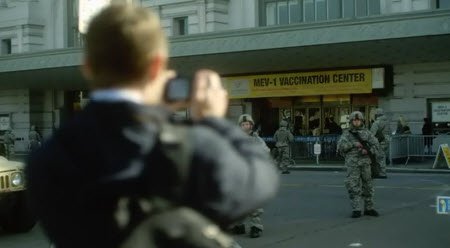
The only solution to do virus problem? A mass vaccination campaign.
Those who receive the vaccine get the privilege of wearing a scannable wristband. This allows them to go to public places such as shopping malls.

You get vaccinated, you get a barcode that allows you to go places. You don’t get vaccinated, you stay at home … and you die.
In Conclusion
Contagion may be presented as a work of fiction, but it communicates several important messages that authorities need the public to accept. To do so, the movie defines a specific problem that has actually occurred in the past, it identifies the agencies that have the right to take charge of the situation and proposes the only solution required to fix the problem. That solution is not pretty: The dissolution of the government, the imposition of martial law, the creation of civilian camps, forced vaccination campaigns, and the suppression of free speech. Democracy and civil rights are suspended and we witness the establishment of a highly controlled and monitored society (using barcodes).
Are disaster movies such as Contagion solely created for entertainment or are they also used to teach the public about what is acceptable and what is not when a disaster occurs? Would the World Health Organization participate in a movie simply to entertain people? Interesting fact: The movie was released on DVD at the same time the WHO got accused of exaggerating the death rate of the new H5N1 bird flu. The WHO has also recently allowed the publication of controversial research describing the creation of a mutant and highly contagious version of the virus. Could a weaponized version of the virus be purposely released to the public to justify martial law? Wait, maybe I shouldn’t say things like that. I don’t want to get arrested for “security fraud, conspiracy, and most likely manslaughter”.
- Nicaragua's president Daniel Ortega is on a mission to eradicate Christianity.
- Deftones promo for "Around the Fur" album (circa 1997)
- Live Streamers Allegedly Bust Prominent Hollywood Producer Herschel Alan Weingrod During Interaction With A Minor
- The truth is coming out: Mind control weapons do exist and they're being used on people
- Food that contains aborted fetal cells
- Well known entertainment reporter, Sam Rubin, dies suddenly age 64.
- The Hidden Meaning of Madonna's Show in Rio de Janeiro
Get an e-mail notification as soon as a new article is published on The Vigilant Citizen.
-

 Vigilant Reports3 months ago
Vigilant Reports3 months agoSuper Bowl 2024 Was a Circus Involving a Clown Wearing an Inverted Cross
-

 Movies and TV2 months ago
Movies and TV2 months agoThere’s Something Terribly Wrong With “Poor Things”
-

 Pics of the Month3 months ago
Pics of the Month3 months agoSymbolic Pics of the Month 02/24
-

 Music Business2 months ago
Music Business2 months agoThe Blatant Luciferian Symbolism in Justin Timberlake’s “No Angels”
-

 Pics of the Month1 month ago
Pics of the Month1 month agoSymbolic Pics of the Month 04/24
-

 Music Business2 months ago
Music Business2 months agoPoppy’s “V.A.N”: One of the Most Blatant MKULTRA Videos Ever Made
-

 Music Business2 weeks ago
Music Business2 weeks agoThe Sinister Meaning of Taylor Swift’s “Fortnight”
-

 Music Business1 month ago
Music Business1 month agoThe Cringy Symbolism in Jojo Siwa’s “Karma”











